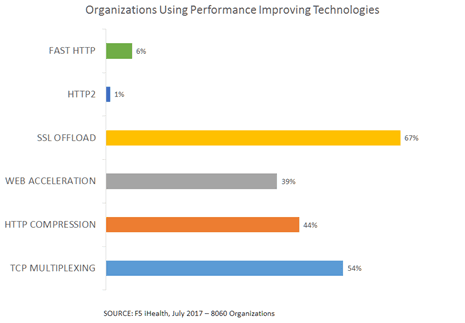Insights from the State of Application Delivery 2017
The transition from HTTP/1x to HTTP/2 is of great interest given its potentially disruptive impact. With incompatibility between the two, the deployment of a gateway to enable the performance benefits of HTTP/2 for clients without forklift upgrades of applications is becoming a popular means of migration.
According to W3Techs, which tracks the status of a variety of web technologies across the top sites, reports that HTTP/2 is used by 10.9% of all websites as of Dec 2016. Interestingly, 25% of all respondents in our State of Application Delivery 2017 survey have an HTTP/2 gateway deployed, and 27% indicate they plan to deploy one in the next 12 months. Granted, deployment does not mean in use, though it’s reasonable to assume that most organizations do not deploy services they don’t actually use.

The most aggressive industries may (at first) be surprising. Cloud Service Providers (CSP), government, and natural resources are leading existing deployments. CSPs, healthcare, and manufacturing lead those industries with the most aggressive plans to deploy in the next twelve months.
Interestingly, investment plans of industries with planned HTTP/2 gateway deployments also showed a commitment to mobile applications, with natural resources (38%), healthcare (35%), and government (31%) leading investment plans for mobile apps. Approximately 1 in 5 organizations in every industry (the exception being education, which is slightly less) plans on investing in mobile apps in 2017.
That’s relevant to HTTP/2 because mobile applications are known to suffer from many performance issues the latest standard purports to resolve. This may explain the perhaps odd fascination with HTTP/2 shown by traditionally non-leading edge technology industries. Further proof, conceivably, of the importance of the digital economy and transformation of businesses regardless of industry.
While many view digital transformation from the perspective of consumer-facing applications and digital replacements for traditional paper-based communications, a great deal of that transformation takes place internally with a focus on productivity across every line of business. Business processes are being orchestrated, tasks automated, and all are initiated, fed, and managed via digital mechanisms. From web apps to mobile apps to things, a great deal of digital transformation has to occur internally, out of the limelight that shines on what an organization has to offer externally to consumers.
In fact, Apperian, in its 2016 Executive Enterprise Mobility Report, noted that the “primary benefits of mobility include improved business processes and improved productivity, cited by 53% of respondents.” Digging into the specifics, 56% of respondents view productivity apps as having the most positive business impact (measured as productivity improvements, ROI, etc…) and half (50%) pegged field service applications.
Natural resources, whose domain includes those who traverse a wide variety of natural environments, are often only connected via mobile devices. Sensors and things are enabling manufacturing, all of which still need to talk to “the mothership”, and cloud providers… well, cloud providers are finally looking to address the needs of enterprises with respect to the app services they need to make apps faster and safer for consumers and corporate users alike. That appears, in part, to play into the rising focus on HTTP/2.
Digital transformation of the business must necessarily be reflected in the technologies and tools used to enable it. That means technologies like HTTP/2 gateways that address issues that can impede organizations from realizing its benefits.
About the Author

Related Blog Posts

AppViewX + F5: Automating and orchestrating app delivery
As an F5 ADSP Select partner, AppViewX works with F5 to deliver a centralized orchestration solution to manage app services across distributed environments.

Build a quantum-safe backbone for AI with F5 and NetApp
By deploying F5 and NetApp solutions, enterprises can meet the demands of AI workloads, while preparing for a quantum future.

F5 ADSP Partner Program streamlines adoption of F5 platform
The new F5 ADSP Partner Program creates a dynamic ecosystem that drives growth and success for our partners and customers.
F5 NGINX Gateway Fabric is a certified solution for Red Hat OpenShift
F5 collaborates with Red Hat to deliver a solution that combines the high-performance app delivery of F5 NGINX with Red Hat OpenShift’s enterprise Kubernetes capabilities.
F5 Silverline Mitigates Record-Breaking DDoS Attacks
Malicious attacks are increasing in scale and complexity, threatening to overwhelm and breach the internal resources of businesses globally. Often, these attacks combine high-volume traffic with stealthy, low-and-slow, application-targeted attack techniques, powered by either automated botnets or human-driven tools.
Phishing Attacks Soar 220% During COVID-19 Peak as Cybercriminal Opportunism Intensifies
David Warburton, author of the F5 Labs 2020 Phishing and Fraud Report, describes how fraudsters are adapting to the pandemic and maps out the trends ahead in this video, with summary comments.
